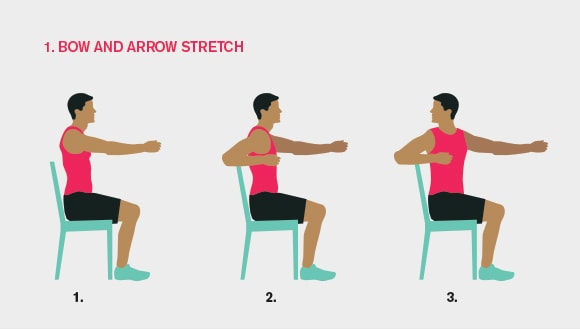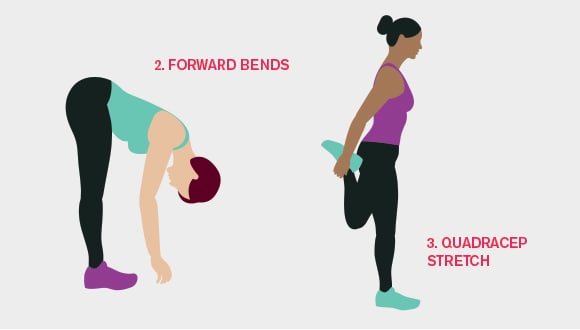Why stretch? And 3 easy exercises to get you started
Simply bending over and touching your toes every day can help with maintaining good muscle and overall health. Here’s how to stretch correctly and why it’s so good for you.
Health Agenda magazine
April 2019
Whether it’s been a hard day at the keyboard or a long session in the garden, gentle stretching can help relieve tense muscles and keep stiffness at bay, so you can stay active and maintain flexibility.
Stretching exercises can bring balance to tightened and shortened muscle fibres, which often happens after periods of immobility or strenuous exercise.
“Most of us will benefit from stretching, particularly of those muscles that tend to spend a lot of time in a shortened position,” says Adelaide physiotherapist Tory Toogood.
“It’s particularly useful if you’re a bit stiff or tend towards being tight in particular muscle groups because you spend a lot of your time sitting, whether that’s at work or driving”, or during hobbies like reading or watching TV.

How stretching helps
Muscles are made up of blood-filled fibres that contract to move our skeleton. Tight muscles can impact the range of movement of your joints, which may cause pain and stiffness.
“If you have a muscle that’s tight, it might tend to pull a joint towards one side consistently, which could mean that there are uneven forces acting on the joint,” says Toogood.
This could put you at risk of damage or injury. Gently lengthening muscle fibres helps joints achieve their full range of motion. Plus Tory Toogood says stretching can:
- encourage the lengthening not only of muscles, but of associated tendons as well
- boost circulation – blood can pool a little in muscles when they're not active, so when the muscles contract, it’s like squeezing a sponge, which helps move the blood along
- help recovery
- prevent pain and balance problems
- keep you active and ensure you can do daily tasks.
Stretching: how tos
It’s worth doing a light warm-up for 5-10 minutes before you stretch. Stretches don’t need to be intense or held for long periods to be effective, and your range of motion may be limited at first but after a few holds your flexibility should increase. Here’s what a good stretch entails says Toogood:
How hard? “You should be able to feel a sense of lengthening and letting go in the muscle, but you don’t want to reach that point of stretch where there is pain.”
How long? This depends on what you want to achieve and how short the muscle fibre is, but generally holding the stretch for between 8 and 10 seconds is enough.
How many? Do 3 sets of holds on each side. “So you lengthen it out, hold for 8 to 10 seconds, give it a bit of a shake and then bring it back up again into the stretch position,” she says.
How often? Doing each stretch 1–2 times a day is a good start.
When it’s great to stretch
Sitting: “If you have a sitting job it’s a good idea to have a bit of a wriggle and move every 30 to 45 minutes,” says Toogood. “Do a shoulder roll, take a short walk to the printer, make a cup of tea or get a glass of water.”
Injury: Stretching can be an essential part of rehabilitation after certain muscle injuries, as it helps counteract the immobility that may come with the injury, or problematic movement patterns that develop as a result. Check with your doctor about what (if any) stretches you should do if you’re injured.
After exercise: The perfect time for stretches is after activity when your muscles are warm and plump with blood.
As you age: Like the skin on your face, the connective tissues between joints become more fragile with age, so stretching can help maintain the flexibility of your joints.
Simple stretching exercises
These stretches from Toogood can be done almost anywhere, anytime. If you're unsure of how to do them or whether you should be doing them, chat to a health professional.
1. Bow and arrow stretch
Sit in a chair with both hands forward. Pull one hand back as though you are drawing a bow. Overdo the action a little and look around towards the back elbow to get a twist through your back. Then change arms and direction.
2. Forward bends
Stand up, bend all the way forward, then relax and hang there, feeling a stretch through your back, hamstrings, hips and calves.
3. Quadricep stretch
Standing up, lift one leg up behind your bottom and hold onto the front of your ankle. Try to keep your knees together and your body upright. Repeat on the other side.


Related articles
EXERCISE FOR HEALTHY BONES
Bone health is a key factor in ageing well and exercise can help you build stronger, denser bones.
HOW TO MOVE MORE AT WORK
Finding ways to build movement into your day can deliver huge health benefits – now and into the future.
IS YOGA IS GOOD FOR YOU?
More people every year are turning to yoga, but are there proven health benefits?